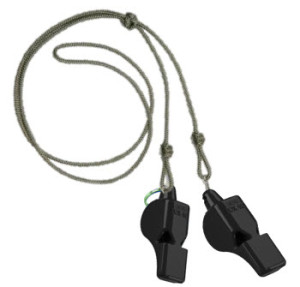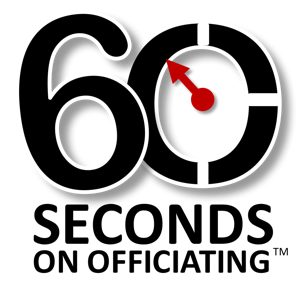
Untangling the Double Whistle
You have a block and your partner has a player control foul. What are we to do? Read this and you will know.
Now if you have been officiating for any length of time you likely have experienced first-hand, or know a referee who has been caught up in the unenviable situation of dealing with a block/charge (sometimes referred to as a “blarge”) scenario that has two officials blowing their whistle and both giving different preliminary signals.
This even happens at the highest competitive level of our game. Check out this 2 1/2 minute NCAA video first and then read more below on how to administer this same scenario if it happens to YOU in a scholastic game.
Here is a recap of the situation seen in the video.
- This is a crew of three top notch and very competent referees, and as the video shows, this ‘blarge’ situation can happen to the best of us.
- Contact occurs in the lane area between a ball handler (White-31) and a defender (Black-50).
- It is in a grey area at the intersection of both officials Primary Coverage Areas (PCAs).
- The Lead official AND the Center official both signal a foul has occurred.
- Both officials (Lead and Center) do not make eye contact with one another and move quickly to demonstrate a preliminary signal based on their individual ruling.
- The Center official is ruling this play a player control/charging foul on White-31.
- The Lead official is ruling this play a blocking foul on Black-50.
How do you handle or avoid this situation in YOUR scholastic game?
Let’s start with these two basic questions.
Can BOTH officials be correct?
Is it possible to have TWO DIFFERENT FOUL RULINGS charged on one play?
Premise #1: No to both questions.
Only one official could be correct here and we need to get the call right.
If the two calling officials would have made eye contact with one another after stopping the clock (signal) and BEFORE showing their preliminary spot-of-the-foul signal, this confusion could have been avoided. Put this talk track into your pre-game discussion for EVERY game with your crew.
 Let’s make sure on every foul whistled you grab eye contact with the nearest official to make sure there is not a double whistle. Especially in the lane area and drives to the basket.
Let’s make sure on every foul whistled you grab eye contact with the nearest official to make sure there is not a double whistle. Especially in the lane area and drives to the basket.- If you do have a double whistle before either official signals – you should indicate verbally (i.e. “you take it”) or come together (as a crew) and determine which official should make the ruling.
- There should be no preliminary signals given (during a double whistle) from the outside official(s). This includes both the Center and Trail official (crew of 3) and the Trail official (crew of 2).
- Many times, as a 3 person crew, you will defer to the official whose PCA was where the play originated. For a 2 person crew you should defer to the Lead official (play coming toward them) to make the ruling. However, each situation dictates clear communication on this and may vary.
- In all cases where you are stuck, a quick discussion (as the entire crew) can sort out who had the best angle, look and timing on the play to make the accurate single ruling.
- After discussing don’t forget to report this ruling to the table.
Premise #2: Yes to both questions.
By rule, both officials made a ruling – so a double foul must be penalized.
Since the officials did not make eye contact or communicate as a crew at the spot-of-the-foul you are given little choice here. Here is the less than desired scenario talk track you can also include in your pre-game discussion in case it arises.
- If you mistakenly have a double whistle and signal two different rulings you will administer a double foul for the play.
- Both players are given a personal foul as reported to the table.
- These fouls go toward the team totals for the bonus situation – but no free-throws will be awarded.
- Pick up the game at the point of interruption (POI). If team control exists at the POI, award that team the ball at the nearest spot to the double foul.
- If no team control exists (i.e. after the try is released) you will need to wait to see the outcome of the try. If the try is successful, the goal will be scored with the point of interruption being the ensuing throw-in. If the try is unsuccessful, you will need to look to the Alternating Possession Arrow. Whichever team the A-P arrow favors, that team will receive the ball after the foul is reported under the A-P procedure. The double foul would not cause the ball to become dead on on the try.
Remember no free-throws are awarded on a double foul in which both fouls are personal fouls or technical.
An Ounce of Prevention
To review, it is all about communication to lessen the likelihood of these situations. Interpreter and clinician Al Battista recommends the following 4 critical steps to keep you out of trouble during a double whistle.
- Gain eye contact. Make sure both officials acknowledge there is a double whistle.
- Go to the play. Both officials should converge and move toward the spot of the foul. Get in closer proximity to one another.
- Voice Acknowledgement. As discussed in the pregame preparation, one official will say “I got it” or “You take it.”
- Signal Last. Once taken by the administering official (both visually and audibly) it’s now appropriate to display the preliminary signal, at the spot of the foul. Make sure to sell it with a strong and crisp voice and signal!
The communication starts in your pregame discussion and carries forward to the live game scenarios where double whistles, as we seen in the above video, can occur to even the best officials. Best of luck in untangling your double whistle!
Rules References
4-19-8, 10-6-12 Pen 1c
Casebook 4.19.8 Situation C

Billy,
Thank you for this article. It is full of valuable information. One slight adjustment is needed in my opinion. You write under Premise #1: “For a 2 person crew you should defer to the Lead official(play coming toward them) to make the ruling.”
In the Basketball Officials Manual(2-Official Crew), concerning drives to the basket: “When a player with the ball starts a drive to the basket from an official’s primary area, that official has primary coverage of the player and the ball all the way to the basket – even if the ball moves into the other official’s primary area.”
I am grateful for and have benefited from your wisdom on this site. Thank you.
Eddie Morris
Excellent article Billy. If we go to the arrow due to the ball being released prior to double foul, shot clock is reset regardless of who receives the alternating possession, correct?
Thank you!
Andrew
Being that I was at the game and throwing my Purdue Allegiance aside, I would have gone with Paul’s Whistle since he had the better angle on the play!